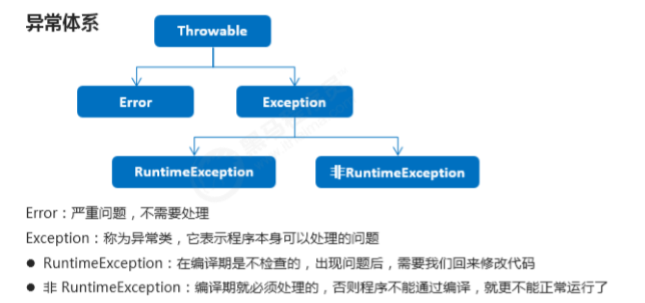目录
1、异常
异常的概述
异常就是程序出现了不正常的情况
异常的体系结构

2、JVM默认处理异常的方式
如果程序出现了问题,我们没有做任何处理,最终JVM 会做默认的处理,处理方式有如下两个步骤:
把异常的名称,错误原因及异常出现的位置等信息输出在了控制台
程序停止执行
package com.itheima_01; /* JVM的默认处理方案 */ public class ExceptionDemo02 { public static void main(String[] args) { System.out.println("开始"); method(); System.out.println("结束"); } public static void method() { int[] arr = {1, 2, 3}; // System.out.println(arr[1]); System.out.println(arr[3]); } } /* 开始 Exception in thread "main" java.lang.ArrayIndexOutOfBoundsException: Index 3 out of bounds for length 3 at com.itheima_01.ExceptionDemo02.method(ExceptionDemo02.java:16) at com.itheima_01.ExceptionDemo02.main(ExceptionDemo02.java:9) */

3、try-catch方式处理异常
定义格式

执行流程
程序从 try 里面的代码开始执行
出现异常,就会跳转到对应的 catch 里面去执行
执行完毕之后,程序还可以继续往下执行
示例代码
package com.itheima_02; /* try { 可能出现异常的代码; } catch(异常类名 变量名) { 异常的处理代码; } */ public class ExceptionDemo01 { public static void main(String[] args) { System.out.println("开始"); method(); System.out.println("结束"); } public static void method() { try { int[] arr = {1, 2, 3}; System.out.println(arr[3]); System.out.println("这里能够访问到吗"); } catch (ArrayIndexOutOfBoundsException e) { // System.out.println("你访问的数组索引不存在,请回去修改为正确的索引"); e.printStackTrace(); } } }
4、Throwable成员方法
常用方法

示例代码
package com.itheima_02; /* public String getMessage():返回此 throwable 的详细消息字符串 public String toString():返回此可抛出的简短描述 public void printStackTrace():把异常的错误信息输出在控制台 */ public class ExceptionDemo02 { public static void main(String[] args) { System.out.println("开始"); method(); System.out.println("结束"); } public static void method() { try { int[] arr = {1, 2, 3}; System.out.println(arr[3]); //new ArrayIndexOutOfBoundsException(); System.out.println("这里能够访问到吗"); } catch (ArrayIndexOutOfBoundsException e) { //new ArrayIndexOutOfBoundsException(); // e.printStackTrace(); //public String getMessage():返回此 throwable 的详细消息字符串 // System.out.println(e.getMessage()); //Index 3 out of bounds for length 3 //public String toString():返回此可抛出的简短描述 // System.out.println(e.toString()); //java.lang.ArrayIndexOutOfBoundsException: Index 3 out of bounds for length 3 //public void printStackTrace():把异常的错误信息输出在控制台 e.printStackTrace(); // java.lang.ArrayIndexOutOfBoundsException: Index 3 out of bounds for length 3 // at com.itheima_02.ExceptionDemo02.method(ExceptionDemo02.java:18) // at com.itheima_02.ExceptionDemo02.main(ExceptionDemo02.java:11) } } } /* public class Throwable { private String detailMessage; public Throwable(String message) { detailMessage = message; } public String getMessage() { return detailMessage; } } */
5、编译时异常和运行时异常的区别
编译时异常
都是Exception类及其子类
必须显示处理,否则程序就会发生错误,无法通过编译
运行时异常
都是RuntimeException类及其子类
无需显示处理,也可以和编译时异常一样处理
package com.itheima_02; import java.text.ParseException; import java.text.SimpleDateFormat; import java.util.Date; /* Java 中的异常被分为两大类:编译时异常和运行时异常,也被称为受检异常和非受检异常 所有的 RuntimeException 类及其子类的实例被称为运行时异常,其他的异常都是编译时异常 编译时异常:必须显示处理,否则程序就会发生错误,无法通过编译 运行时异常:无需显示处理,也可以和编译时异常一样处理 */ public class ExceptionDemo03 { public static void main(String[] args) { // method(); method2(); } //编译时异常 public static void method2() { try { String s = "2048-08-09"; SimpleDateFormat sdf = new SimpleDateFormat("yyyy-MM-dd"); Date d = sdf.parse(s); System.out.println(d); } catch (ParseException e) { e.printStackTrace(); } } //运行时异常 public static void method() { try { int[] arr = {1, 2, 3}; System.out.println(arr[3]); } catch (ArrayIndexOutOfBoundsException e) { e.printStackTrace(); } } }
6、throws方式处理异常
定义格式

示例代码
package com.itheima_03; import java.text.ParseException; import java.text.SimpleDateFormat; import java.util.Date; /* throws 异常类名; 这个格式是跟在方法的括号后面的 */ public class ExceptionDemo { public static void main(String[] args) { System.out.println("开始"); // method(); try { method2(); }catch (ParseException e) { e.printStackTrace(); } System.out.println("结束"); } //编译时异常 public static void method2() throws ParseException { String s = "2048-08-09"; SimpleDateFormat sdf = new SimpleDateFormat("yyyy-MM-dd"); Date d = sdf.parse(s); System.out.println(d); } //运行时异常 public static void method() throws ArrayIndexOutOfBoundsException { int[] arr = {1, 2, 3}; System.out.println(arr[3]); } }
注意事项
这个throws格式是跟在方法的括号后面的
编译时异常必须要进行处理,两种处理方案:try...catch …或者 throws,如果采用 throws 这种方案, 将来谁调用谁处理
运行时异常可以不处理,出现问题后,需要我们回来修改代码
7、throws和throw的区别
8、自定义异常
自定义异常类

示例代码
package com.itheima_04; public class ScoreException extends Exception { public ScoreException() {} public ScoreException(String message) { super(message); } } // -------------------------------------------------------------------------- package com.itheima_04; public class Teacher { public void checkScore(int score) throws ScoreException { if(score<0 || score>100) { // throw new ScoreException(); throw new ScoreException("你给的分数有误,分数应该在0-100之间"); } else { System.out.println("成绩正常"); } } } // ----------------------------------------------------------------------- package com.itheima_04; import java.util.Scanner; public class Demo { public static void main(String[] args) { Scanner sc = new Scanner(System.in); System.out.println("请输入分数:"); int score = sc.nextInt(); Teacher t = new Teacher(); try { t.checkScore(score); } catch (ScoreException e) { e.printStackTrace(); } } }
